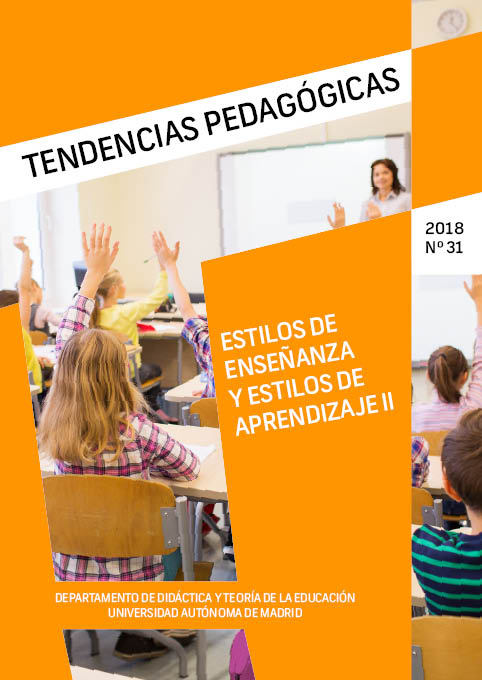Higher education students' learning styles and access to virtual environment tools
Keywords:
learning styles, CHAEA, higher education, virtual learning environment, access to digital toolsAbstract
This study focuses on the issue involving higher education students’ learning styles and the use of digital tools. It was conducted with a sample of 79 undergraduates and its main aim was to determine the influence that learning styles may have on the access to the tools of the virtual environment of a higher education institution, a platform supported by the collaborative environment Sakai. In the light of the results obtained, it was found that the reflective style was the one which showed the highest mean of the scores obtained concerning the subjects’ learning styles, and that the tool which showed the highest number of accesses was the Resources tool.Downloads
References
Alonso, C., Gallego, D. & Honey, P. (1999). Los estilos de aprendizaje: Procedimientos de diagnóstico y mejora (4th ed.). Bilbao: Ediciones Mensajero.
Alves, L., Barros, D. M. V., Okada, A. (2009). Moodle: Estratégias pedagógicas e estudo de caso. Salvador: Eduneb, p.394. Disponível online em: http://livromoodle.blogspot.com/
Barros, D. (2013) Estilos de aprendizagem e o uso das tecnologias. De facto editores: Santo Tirso, Portugal.
Bender, T. (2003). Discussion-based online teaching to enhance student learning: Theory, practice and assessment. Sterling, Virginia: Stylus Publishing, LLC.
Carol, C. (2015). Learning styles in Higher Education. A case study in History training. Procedia - Social and Behavioral Sciences 180, 256 – 261.
https://doi.org/10.1016/j.sbspro.2015.02.113
Cela, K., Fuertes, W., Alonso, C., & Sánchez, F. (2010). Evaluación de herramientas web 2.0, estilos de aprendizaje y su aplicación en el ámbito educativo. Revista Estilos de Aprendizaje, 5(5), 117-134.
Creswell, J. (2014). Research design: Qualitative, quantitative, and mixed methods approaches (4th ed.). London: SAGE Publication Ltd.
Gallego, D. & Alonso, C. (2010). Estilos de Aprendizaje. In J. Cué, J. Rineón, e M. Velázques Editors, IV Congreso Mundial de Estilos de Aprendizaje, pp. 24-48. México: México.
Fatahi, S., Moradi, H., Kashani-Vahid, L. (2016). A survey of personality and learning styles models applied in virtual environments with emphasis on e-learning environments, Artificial Intelligence Review, 46(3), 413–429.
https://doi.org/10.1007/s10462-016-9469-7
Gallego, D. (2013). Ya he diagnosticado el estilo de aprendizaje de mis alumnos y ahora qué hago? Revista de Estilos de Aprendizaje, 11(12), 1-15.
Graf, S., Liu, T., & Kinshuk (2010). Analysis of learners' navigational behaviour and their learning styles in an online course. Journal of Computer Assisted Learning, 26, 116–131.
https://doi.org/10.1111/j.1365-2729.2009.00336.x
Honey, P. & Mumford, A. (1992). The manual of learning styles. Maidenhead: Peter Honey.
Hung, Y., Chang, R., Lin, C. (2016). Hybrid learning style identification and developing adaptive problem-solving learning activities. Computers in Human Behavior, 55, 552-561.
https://doi.org/10.1016/j.chb.2015.07.004
Küçük, M., Genç-Kumtepe, E. & Tac, D. (2010). Support services and learning styles influencing interaction in asynchronous online discussions. Educational Media International, 47(1), March 2010, 39–56.
https://doi.org/10.1080/09523981003654969
Kumar, R. (2011). Research methodology: A step-by-step guide for beginners. London: SAGE Publication Ltd.
Maroco, J. (2010). Análise estatística: Com utilização do SPSS (3.ª Ed.). Lisboa: Edições Sílabo.
Miranda, L., Morais, C., Goulão, F., & Melaré, D. (2012). Estilos de aprendizagem: Uso do virtual por alunos do ensino superior. Revista de Estilos de Aprendizaje, 1(10), Octubre de 2012, 184-195.
Morais, C. (2000). Complexidade e comunicação mediada por computador na aprendizagem de conceitos matemáticos: Um estudo no 3.º ciclo do ensino básico. Tese de Doutoramento em Educação - Área do Conhecimento de Metodologia do Ensino da Matemática. Braga: Universidade do Minho.
Moreno, J. & Defude, B. (2010). Learning styles and teaching strategies to improve the SCORM Learning Objects Quality. In Steimle, Jürgen (ed.) Proceedings of the 10th IEEE International Conference on Advanced Learning Technologies ICALT10, pp. 414-416, July 5-7, Sousse, Tunisia.
https://doi.org/10.1109/icalt.2010.121
Özyurt, Ö. & Özyurt, H.(2015). Learning style based individualized adaptive e-learning environments: Content analysis of the articles published from 2005 to 2014, Computers in Human Behavior, 52 (November 2015), 349-358.
https://doi.org/10.1016/j.chb.2015.06.020
Pereira, A. (2004). Guia prático de utilização do SPSS. Lisboa: Edições Sílabo.
Rodríguez, A., Lozano, D., Aradillas, A., & Duque, E. (2011). Uso de google docs como herramienta de construcción colaborativa tomando en cuenta los estilos de aprendizaje. Revista Estilos de Aprendizaje, 8 (8), 23-29.
Truong, H. (2016). Integrating learning styles and adaptive e-learning system: Current developments, problems and opportunities, Computers in Human Behavior, 55, 1185-1193.
https://doi.org/10.1016/j.chb.2015.02.014
Zacharis, N. Z. (2011). The effect of learning style on preference for web-based courses and learning outcomes. British Journal of Educational Technology, 42(5), 790-800.

